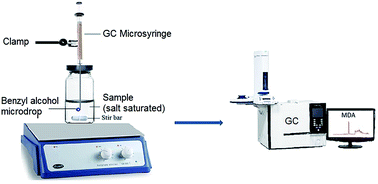Salt saturated single-drop microextraction of malondialdehyde from human plasma before its determination by gas chromatography
Abstract
A fast, simple and reliable method was introduced and developed for the determination of malondialdehyde (MDA) in human blood plasma samples based on salt saturated single drop microextraction (SS-SDME) followed by gas chromatography/flame ionization detection. This is the first report of the extraction of a biochemical species by SS-SDME which utilizes a polar solvent. After saturation of the human serum with NaCl, Mg(NO3)2 and KNO3 salts, 0.8 μL of benzyl alcohol was directly added to the sample to extract its MDA. Parameters influencing the extraction efficiency such as the type and volume of extracting solvent, volume of sample solution, agitation of the sample, extraction time, temperature and pH were studied and optimized. The developed protocol was found to yield a linear calibration curve in the concentration range of 10 and 1000 μg L−1 with a limit of detection of 0.760 μg L−1. An enrichment factor of 204.4 fold was observed for the analyte. The repeatability of the method was satisfactory (RSD = 8.37%, n = 10) and the total analysis time including microextraction was less than 16 min. The method has been successfully applied for the analysis of MDA in the blood plasma of humans.


 Please wait while we load your content...
Please wait while we load your content...